Eyes In The Sky
The guys from Eyes In The Sky Visuals have put together an aerial surf showreel for your viewing pleasure. This clip features the likes of Ozzy Wright, Craig Anderson, Dion Agius, Alex Knost and more! All the footage featured in this clip has been filmed over the past year from trips up and down the East Coast of Australia. Beware, the next 4 minutes are likely to inspire you to take the day off work tomorrow and chase some waves!
Behind the Scenes with Album Surfboards
Here is a cool behind the scenes look into Album Surfboards and Co-Founder/Shaper Matt Parker’s day to day life. This video is a little older, so their new showroom and head office are now located together in San Clemente.
Matt puts an emphasis on high quality, highly aesthetic, and highly functional surfboards made custom for each individual. He is a true surfer/shaper who can put his money where is mouth is. Everyone that orders a board through Album is not disappointed, in-fact his return business rate is through the roof. Once you go Album you don’t go back!
Popular Album Models include:
Yay Bay!
Here is a little vid to keep you super stoked on J-Bay as the WSL seems to be battling more “down-time”, waiting for some solid swell to arrive. Ricardo Christie and Jay Davies enjoy the spoils of both J-Bay and touring South Africa, all set to a Pink Floyd power ballad that’ll get you pumped to go surf…and to watch the contest when it runs!
Enjoy and then go Surf!
Board talk with Matt Parker
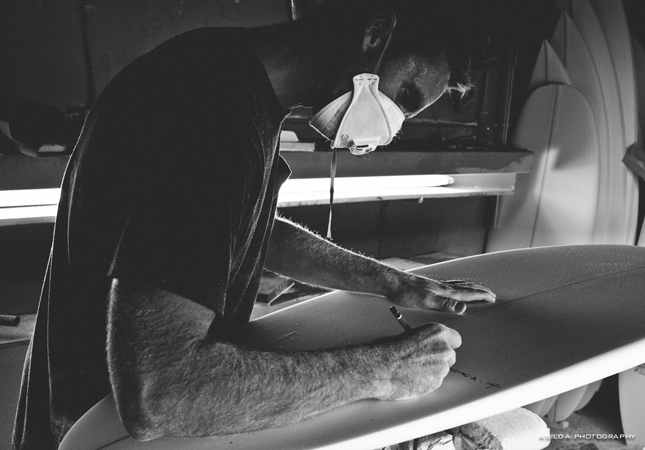
In the shaping bay with Matt Parker. Photo: @asildaphotography.
Matt Parker, head shaper of Album Surfboards recently had a chat with Boardcave about where he got his start, his favorite waves to surf and of course, boards…
When and where did you start shaping?
I started shaping in my garage back in 2000/2001. Just hacking away at foam, figuring out tools and miraculously some of the first boards actually floated and worked a bit.
Which shapers or influences do you have that inspire you?
Surfing, all types of surfing is always the main inspiration. So being immersed in that, surfing everyday sparks that more than anything.
I’m inspired by shapers that have longevity – that have been around, are stoked, have innovated, adapted and are happy.
Delivering stoke to customers every week and hearing good feedback is really awesome – makes all the long hours worth it.
Do you have a favorite type of wave to surf? What board model do you think works best on it?
I love any good wave, but point breaks are probably my favorite because they allow you to do a number of turns, connect sections, find the speed line.
I can get a real sense for what a board is doing at a point.
Small days I love Simmons influenced stubbies like the Symphony or Supersede – if it’s decent any hybrid like a Polyphonic to a UTF to a full blown performance board like a Dischord works insane.
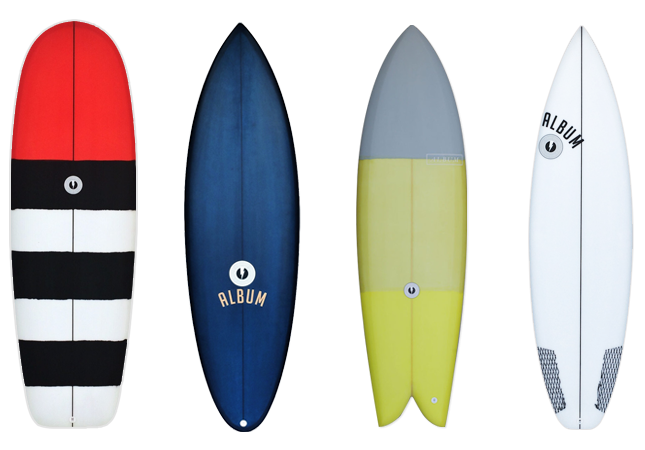
A few from the quiver Symphony, Polyphonic, UTF and the Dischord.
You have some pretty diverse boards in the range, is there a personal favorite amongst them?
I think every board or model we make has its day that it really shines.
The Ledge is probably my favorite to shape – and when you ride it you know the waves are good – so lots of good memories and vibes around that one.
Album Surfboards are known for detailed artwork across your range, where does the inspiration for the artwork come from?
My background is in art and design. I was a design major in school so I guess I see everything through that lens.
I get really bored with the same thing over and over again. I can’t stand doing the same thing over and over again until its played out. I really want the boards to be unique and stand out from everything else that’s out there.
I think psychologically the design and look of the board is super important. If it feels good and looks good its going to surf good. Color is a big inspiration – in nature, art, etc.
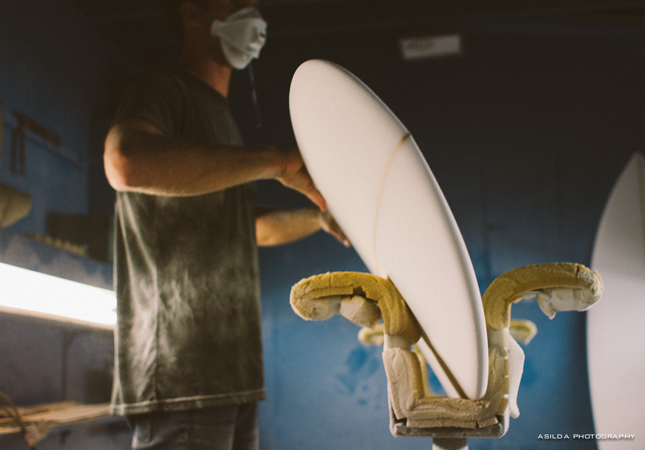
Matt checking the rails on an Album custom. Photo: @asildaphotography.
What gives you the best results when you’re shaping a board: sticking with tradition, experimentation, or is it a combination of both?
Depends on the objective we’re after for a particular board.
I think there are theories, approaches and design elements from the past that just flat out work so it’d be ignorant to ignore that. But I always have to be open minded to try anything. No rules. It’s surfing. I get a lot of joy from experimentation.
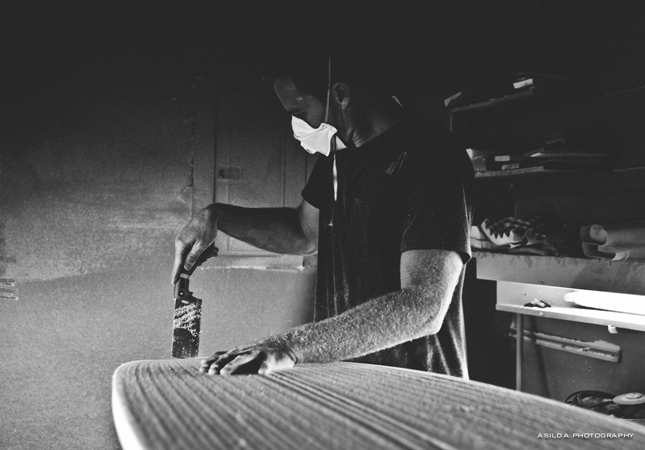
Working on the tail of a fresh board. Photo: @asildaphotography.
It looks like a lot of thought and attention go into every Album model, how do you decide when to release a new shape?
Thanks! The bottom line is basically if I wouldn’t surf it or it doesn’t work for me it’s not going to be a model.
Generally we’ll go through quite a few variations until it all feels right. There’s a lot of overlap with some of our shapes – and for good reason, the kind of surfing we do isn’t totally isolated.
I’m always going to want a board that has versatility – something that works more than just one day a year.

What are the most important things to consider when buying one of your boards?
Really internalize and identify what you’re trying to do on a wave and with your surfing.
Are there areas you want to improve? Are you having fun? Why or why not?
If you can focus on what is going to make surfing the most fun for you – then you’ll always be satisfied and always have good sessions. To me that should be the goal. Make surfing more fun.
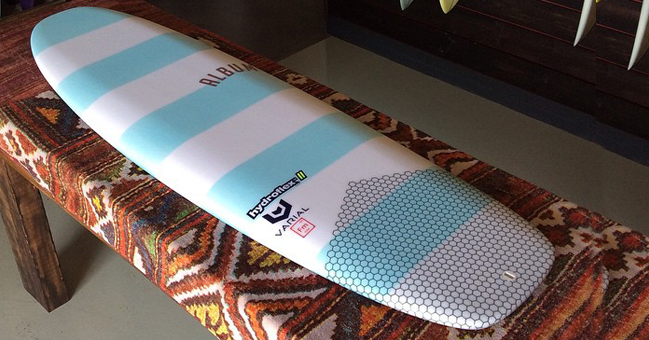
One of Album’s Symphony models all dressed up and ready in hydroflex construction and varial foam.
Any new developments in the works for Album? What’s the plan for the brand in the future?
It’s been a really busy last year!
We opened up a new showroom that’s open to the public in December. It’s been rad to have people come and see the boards and experience what we’re all about in person.
We also expanded to a larger factory so we can increase production and get everyone’s custom orders done quick. We always have some trips planned. Surf everyday there are waves.
Our plan for the year is to nail down a bunch of video content on the models, boards in action, etc so customers can get some more insight into the best board for them. Keep the stoke factor maxxed!
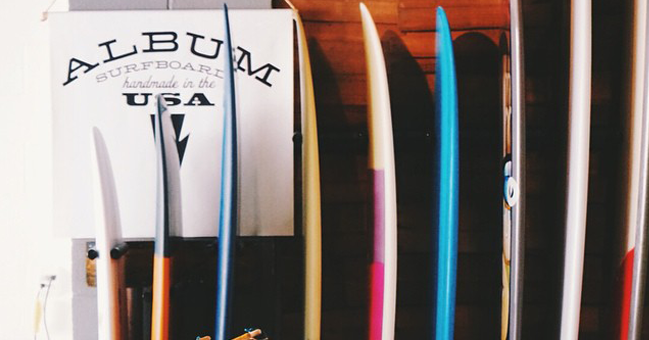
Plenty of boards on racks in the Album Surfboards showroom in San Clemente.
Check out Album Surfboards full range of boards and use the Board Engine to help find your volume.
Thanks to Asilda Photography for use of the images.
Board talk with Al Emery
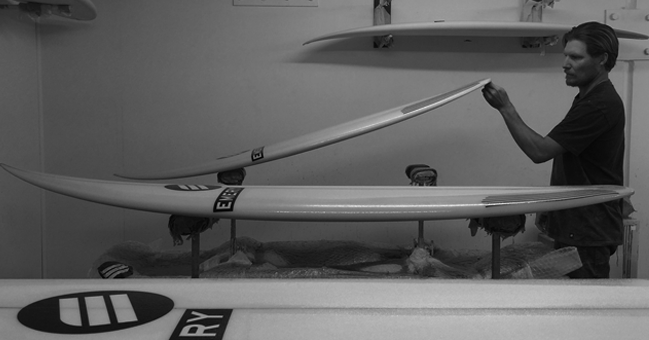
Board Talk with Al Emery
We had a chat with head-shaper Al Emery, of Emery Surfboards about what he likes about surfing, his brand, choosing surfboards and how he sees the industry developing in the next 10 years.
When and where did you get your shaping start?
My dad bought me a blank when I was about 18, I started shaping boards in my backyard around then.
Who were/are the shapers and surfers you looked up to?
I have always liked Al Merrick’s shapes because they are so extreme and I learnt a lot from local shapers in the area over the years.
I always loved Andy Irons surfing, Taj and pretty blown away this year by Felipe.

A couple of performers in the Emery range. On top, the deck and rocker of the Black Angel and below, the deck and rocker of the Stump Thumb.
What style of boards do you enjoy surfing?
I love surfing performance boards and fishes with speed and flow.
Have you had a change of direction in your own shaping at any point?
The core of my board designs has always been about high performance and fun and this is still my main focus.
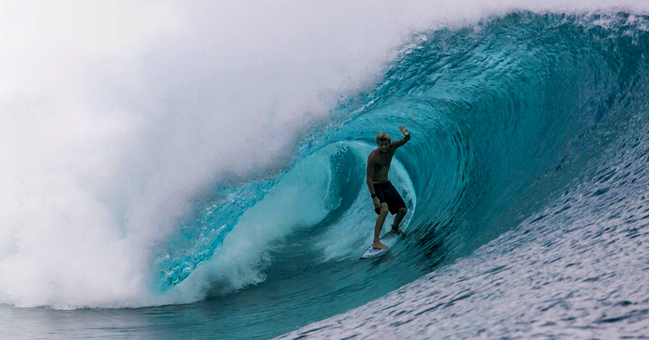
Harry Bryant getting through this nice little barrel.
For custom orders, why should customers choose different constructions eg. PU, EPS, Futureflex ?
PU’s are cheaper for a custom and it the fastest turn around in production time, EPS are lighter and more buoyant and Futureflex is a different flex to your normal stringer with a more even outer parabolic flex.
Do you think the standard PU construction, which has been around the longest, is still the best option?
Yes, it’s very easy to shape, sand and glass for consistency in replicating designs.
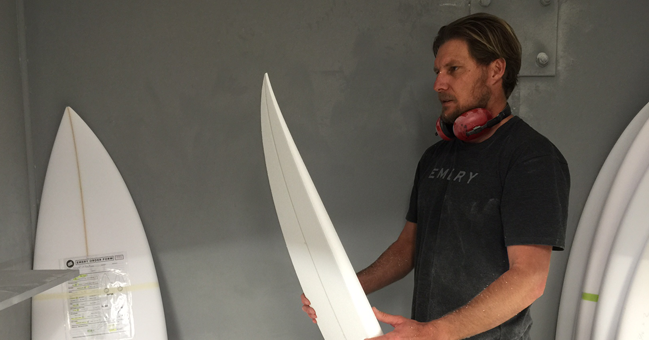
One final check of the forward outline.
What aspects of a board are most important to you? Is volume helpful in determining the right board for someone?
I think the foil of the board from nose to tail is what I most look at when shaping, making sure it’s flows nicely.
Volume is key and definitely helpful when moving from your normal shortboard to other models, it gets you close to what you want straight away.
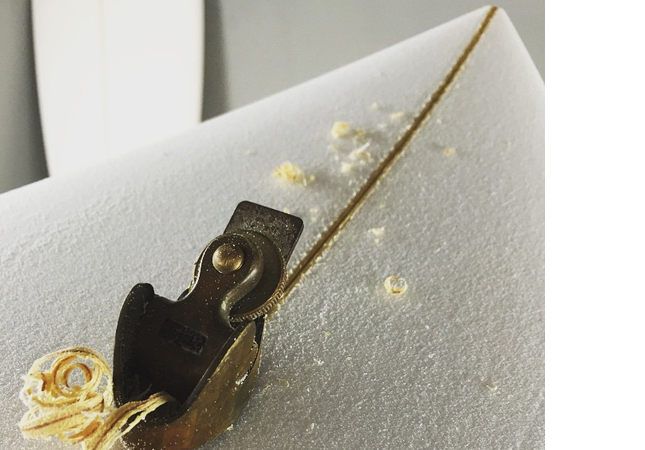
Some stringer attention on a nice looking Emery nose.
We hear your working on some new models, what’s your process for launching a new model? Can you shed some light on these new shapes and what we can look forward to?
We are always working on new projects and models with our team.
I’m constantly tweaking and designing new models with them when they return from comps and trips trying to improve performance on the normal shortboard and also creating super fun crafts.
Our aim is to release something fresh once a year. Yes we have two new models due to be released, ready for summer… stay tuned.

A new project in the works, coming soon for Emery Surfboards showing up on their instagram @emerysurfboards.
Where do you see surfing in the next 10 years? Will there be a push for new constructions, shapes, eco-friendly materials, etc?
EPS is fast growing with performance boards, a lot of surfers are riding them in contests and free surfing which see’s this type of construction growing and definitely moving forward with more eco-friendly materials.
At Emery we are always experimenting with new materials and glassing methods and it is one of my favorite things to do, my mind is always moving towards the next thing.
For more information and their full range of surfboards ready to be customized and order online, check out Emery Surfboards. Use the Board Engine to help find your volume.
Synthetic Sally
Here is a rad video of a super fun wave in Central America and a super fun board, the Synthetic Sally by Blake Peters at Panda Surfboards.
This is Ford Archbold’s signature model with Panda and by the looks of it, he is tearing the bag out of these waves. The board features a wide outline, old school beaked nose, with tons of volume. Combined with higher performance rails and a nice pulled in winged swallow tail, this blend of old and new make for a board that will suit most surfers and can be surfed in a lot of different types of waves and conditions.
We here at Boardcave have always been a huge fan of shorter, wider, full volume boards. The proof is in the pudding that this style of board works. Many brands offer similar elements in many of their models. Don’t be fooled that these hybrid style of boards are only good for smaller or mushy days…take the plunge and leave your traditional shorty at home the next time you local is firing. You will not be disappointed in the results, as it’ll allow you to look at waves in a new way and draw new lines that you can translate back to your shorty with ease.
Have a look at all the boards represented on Boardcave here, and narrow your search to “hybrid” to expand your mind and the possibilities of where surfing can take you.
Choosing The Ideal Construction
We have already had a look at the basic breakdown in the two most commonly used options widely available today, and why one might seem a better fit for you than another PU/PE vs EPS/Epoxy.
Now we will have a look (in no particular order) at a few of the different construction methods and what they mean to your boards characteristics.
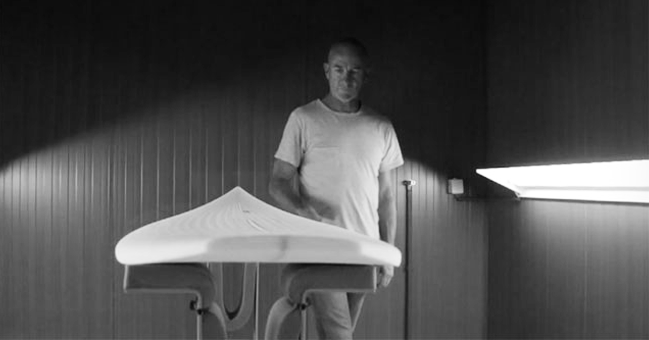
In the DHD Surfboards factory with shaper Darren Handley.
Future Flex
Future Flex, consisting of parabolic carbon reinforced rails, combined with a high density EPS blank and very high quality Epoxy Resin and quad-axial cloth. The blend of these materials translates into a very lively feeling board with lots of projection. The flex and spring back effect of the board gives you a ton of drive and speed.This type of construction has a unique spring back due to the minimal twisting that can happen in other constructions, helping to store and release energy more efficiently. They have a slightly different feel than boards with a stringer under your feet, but once you get used to it, you learn to feel through the board better. The Haydenshapes Hypto Krypto is often ordered in this construction.
Hydroflex
Hydroflex 3D Glassing is a specific method that virtually eliminates the chances of de-lamination of the skin (fiberglass and resin) from the core (foam). They have found a way to literally anchor the skin into the core instead of it just sitting and stick on top of it.This has more affect than just eliminating delam, is also results in an extremely lively and responsive feel to your board.
Hydroflex boards use a high quality Epoxy resin which is stronger and more flexible and Polyester, and gives you a better spring back while being less prone to cracking or delamination. These boards keep their youthful exuberance much longer than most constructions.
Carbon Wrap Technology
Carbon Wrap Technology, exclusive to DMS and Lost boards in Australia (for now), is again a stringers blank with the strategic placement of carbon bands on and around the board.
By wrapping these carbon strips around certain areas of the board, you get a feeling of surfing a board with a lot of “pop”. Flaring the carbon out towards the rail and wrapping it around, allows the board to use it’s contortional twist and translate it to a superior flex giving you more drive when coming out of turns. That added drive with a unique flex patten out the tail gives you a next level feel to your surfing.

Getting some air with a DMS Surfboards model in Carbon Wrap technology.
USC Construction
USC Construction, or “Ultra Stringerless Carbon” construction may be similar to other parabolic carbon boards, but really set’s itself apart by the unique blend of materials and placement of the carbon.
With USC, you are using a stringers blank, but a PU blank instead of EPS. The carbon is also laid around the perimeter, but more on the deck instead of wrapping under the rails.
The PU blank gives you that familiar feel we all know and love, while the parabolic carbon layout adds more speed, drive and flex. Combined with a unique “bio” Polyester resin, these boards lower their carbon footprint while giving you a board you can feel comfortable on as soon as you jump in it.
SUPERflex
SUPERbrand Surfboards brings you their exclusive SUPERflex technology.
The use of a high quality stinger-less blank with a carbon netting along the bottom of the board and carbon reinforced rails. A unique feel in itself, the technology has a superior flex pattern with a quick release for your high performance surfing.
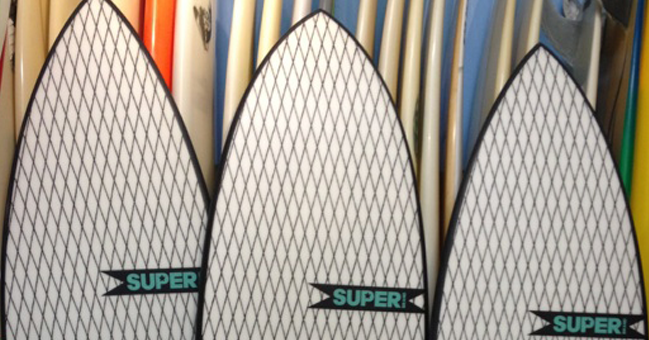
The Superbrand, Superflex technology.
Varial Foam
The technology behind Varial Foam may be new to the Surf Industry, but it has been used in aerospace and automotive applications for quite some time now, from rocket ships to race cars.
This unique foam has a tighter cell structure and a consistent density throughout, and can be used with either polyester or epoxy resins. The strength of the foam actually requires no stinger or any other type of reinforcement other than glassing your boards as standard.
Maybe a small carbon strip for big wave guns to stiffen it up a bit. It is very lightweight with a great flex and springback unlike anything you have felt before. Now really starting to make it’s impact into our beloved industry, you can add this to you options between PU and EPS as your core.
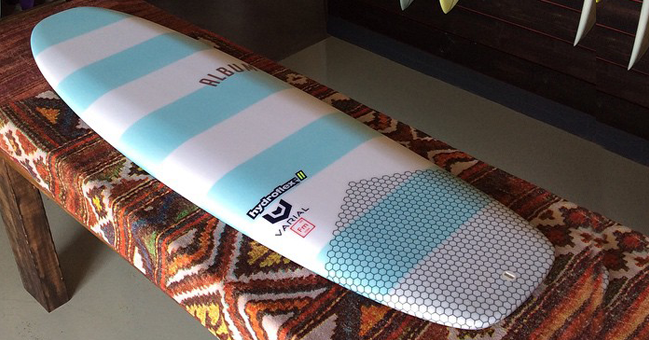
An Album Surfboards model with hydroflex construction and a varial foam blank making this little Symphony look real nice.
General Materials:
All the constructions above have patents on how they are constructed, not the individual materials themselves. With that said, there is still a lot of room for experimentation using and combining these materials.
Carbon Tape
Carbon tape can be used in many ways. Throw it down the center of a board either top, bottom or both, and help stiffen up a board that might be too flexible for it’s intended purpose, or just to simple add strength for a longer lasting board.
You commonly see strips of it on top of the rails at the tail to help prevent the deck from crushing when doing powerful bottom turns when pushing from your heels or toes. Or, like mentioned numerous times above, around the perimeter or wrapped around the board in specific ways to help control flex. The possibilities are endless.
Vector Net
Vector Net is a woven carbon fiber netting that resembles diamond shaped patters. A great way to help reinforce your board while keeping weight down. You can also use this to alter flex patters, or provide structure and longevity for heavy footed surfers.
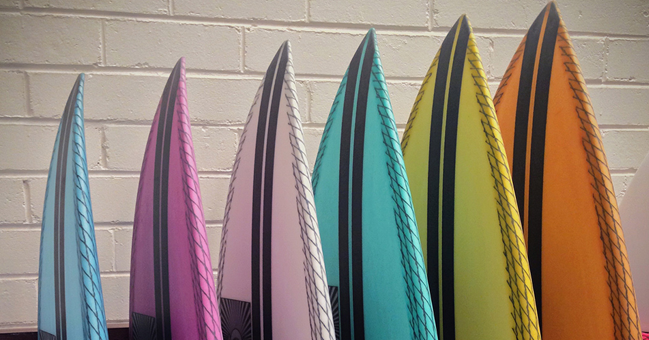
A few Eye Symmetry board models that make use of Magic Fibre construction. Carbon strips underneath and a net on the deck.
Bamboo
Bamboo acts as a great alternative to carbon fiber. A great replacement when you are trying to create a more sustainable surfboard.
Usually found on Epoxy boards as a thin skin over the blank which can then be glassed over lightly. This also helps to reduce the amount of fiberglass and resin needed, again adding to the sustainability of your board while keeping performance levels up.
Cork
Cork is also a unique alternative usually in epoxy constructions. The cork can help to dampen the twitchy feeling you can have on an Epoxy board, and there is almost no need to wax.
Vacuum bagged to the deck of the board that has already been lightly glass, the cork remains exposed, giving you a unique feel under foot and in performance. Added bonus of no more wax on you car seat.
Stringer-less Blanks with No Reinforcement
Going stringer-less all together can result in a super fun board.
Going this route really allows your to feel the wave through the board, giving you more of a feeling of riding with the wave instead of surfing on the wave. Sometimes found with retro inspired Fish designs to help bend, flex and project you around on mushy days.
Using this method on Longboards gives you a totally unique flex pattern when surfing from different parts of the board like from the nose, the middle of the board or off the tail.
Summary
This is just a look at some of the materials that can be used in surfboard construction. We are not trying got favor one over the other, they all have such unique features that play out in different ways.
Most of these can be found on certain brands throughout Boardcave, but there are many more patented and patent pending designs floating around in the surf world that we have not even touched on. The idea behind this article is to just open your mind a little on what can be done with surfboard construction, and why some of these common materials can do for a surfboards performance.
Just like everything else surfboard related, there is an endless combination of designs, materials, constructions and methods that can be played with and have yet to be found still.
That’s what we love the most about surfboards, the best is yet to come and the possibilities are endless. Surfboards will always continue to evolve!
Low Down on the Sweet Spot 2.0
Here it is folks, doesn’t get much better than the man himself, Darren Handley of DHD Surfboards giving you the low down on the Sweet Spot 2.0. Note how he points out the slightly fuller nose for ease of paddling and getting you into waves earlier, but adds a touch more rocker especially through the tail, combined with the double concave to create a super fast board that is highly responsive.
This model is a slight variation on the original Sweet Spot after spending more time testing it is waves all around the world. These adjustments make for a fantastic all-round one board quiver that can handle the majority of waves and conditions you will face day to day. They even beefed up the glass job slightly and added reinforcements over the fin boxes and around the rail at the tail to ensure your board will hold up to what ever beating you may give it.
Board talk with Ryan Engle
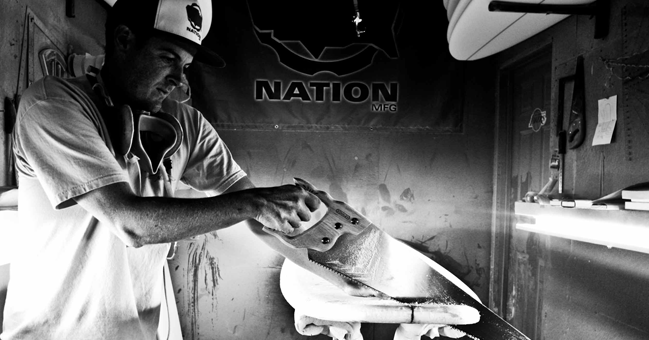
We wanted to get to know head shaper of Nation Surfboards, Ryan Engle a little more so we asked him a few questions about how he got his start, .
When and what got you into shaping?
I always had a close relationship with those who shaped for me as a kid. I was lucky enough to spend a lot of time in the bay, and it grew from there.
What inspires you to shape?
Friends, Family, team-riders and customers STOKE
What do you enjoy most about your job?
Freedom and creativity.
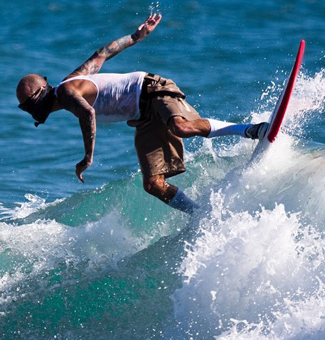
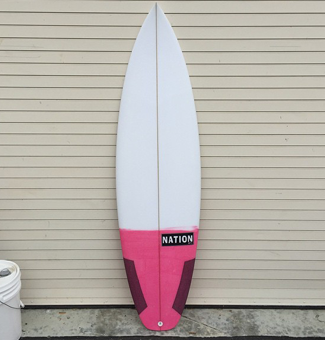
The Los Dos being putting through it’s paces and a nice pink tail dip on the Cool Story model.
You have a pretty diverse range of boards, everything from performance shortboard, traditional logs… do you have a favorite type of board to shape?
My early days as a production shaper started with a wide range of models. I have always taken pride in being very versatile in my shapes and designs. I can’t say I like one over another… I would rather shape a handful of all uniquely different shapes every day. I’m all about keeping the creative juices flowing.
So you don’t have a favorite type of board to shape, but do you have a favorite type of board to surf?
I would lean towards the modern fish realm, but in the same way (as with my shaping), I love switching it up.

The 2015 Nation MFG Surfboards range left to right: The Chub, Stumpy, Los Dos, Sex Machine, Pink Champagne on Ice, Rick Kane Pro, Bro Deal, Cool Story, Steinrider and the Hot Doggin’ Loggin’.
What is your best selling model in the Nation line up and why?
Right now it is the Pink Champagne on Ice. It’s a modern inspired throwback that can go over-sized or stubby; single, tri, or quad. It’s a very versatile board and so it covers a lot of bases. Also, it looks sexy. Sex sells.

A few Nation boards with a little color courtesy of laminating wizard Dave Naylor.
You own your own machine, how has that impacted your job, and is it still vital to be a good “hand-shaper”?
I was really lucky to have worked as a production hand shaper before venturing into the world of CAD. I think everyone needs a solid base in knowing how to properly hand shape a board. That said, using the machine and software, I have gained compete control of my designs from the inside out.
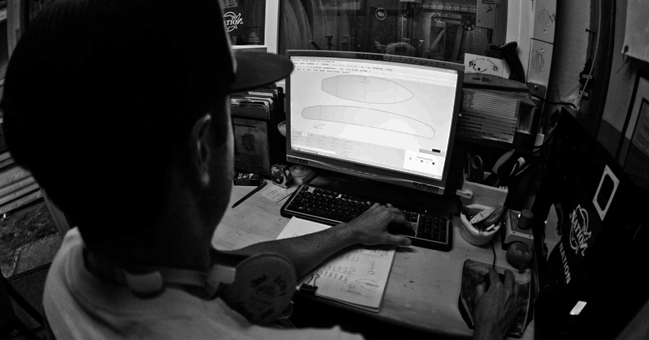
Ryan Engles working on the CAD files to easily refine and progress his board models.
You do really clean work, both shaping glassing and color, what is your quality control process like?
I am very hands on from start to finish. All of my boards are made under one roof and so I get to be there bugging the whole crew daily!
What is the link between Nation Surf and Nation Golf? How did that come about?
My grandpa ran a golf tournament for 30 years. We revamped it in his honor, and are now planning our 9th annual tournament. The golf division of Nation Mfg was born through the growing success and influence of our tournament. The Nation Scramble Classic.
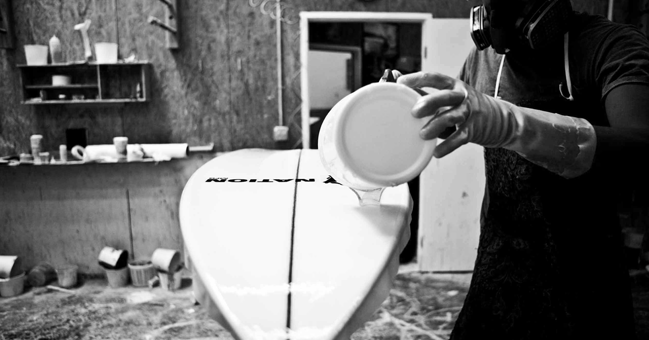
What does the future hold for you and your brand?
I can’t wait to find out! I am very fortunate to have such solid people in my corner, and I am excited to keep enjoying the ride.
For more information and their full range of surfboards ready to be customized and order online, check out Nation Surfboards. Use the Board Engine to help find your volume.
View From a Blue Moon
View From a Blue Moon – A film by Vincent Kueny and Brain Farm, starring Pyzel’s John John Florence.
What Board Should I Surf?
So, maybe by now you’ve had time to build your quiver up to an impressive assortment of boards. All you have to do is know when you can pull each one out and maximize it’s potential and expand your surfing horizon. First of all, let’s take a quick look at that quiver you’ve built. (fairy tale quiver):
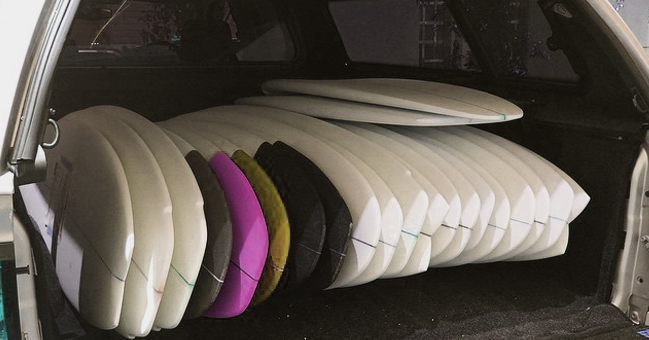
Variety is the spice of life, try as many boards as you can.
Keep in mind, many of these can be surfed in a large variety of conditions. It is really up to you, your style or what “feel” you like when surfing on any given day to decide. However, we can break down each board to what conditions they thrive in and show you how your well-rounded quiver gives you more options than you think. So what board should you surf?
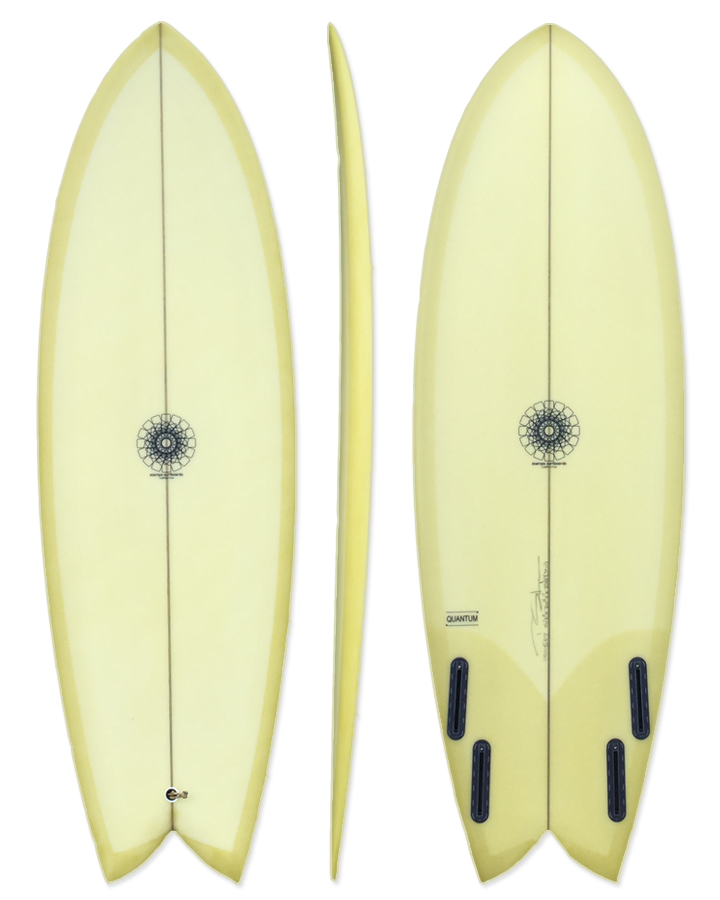
The Quantum Quad Fish , is a board you want to take out if you feel fishy, but want a little more performance and maneuverability. With a quad style fish like this, your rails are usually a little thinner and the bottom contours are more high performance orientated. The quad fin set-up gives you that speed and drive you love, but with more control and maneuverability than the twin keel set up. Anything from knee high to over head is fair game with a board like this. This is a board that can dangerously become your go-to.

The Doinker , and similar boards fit somewhere between a fish and a mini smmons style of board. You can find these boards coming as either a twin keel or quad fin setup. The wide, blunt nose and extra wide tail gives this board plenty of surface area under foot, adding to it’s ability to paddle in early and carry speed through slower sections. But due to the low rocker and a blunt nose, they are not the best in hollow waves as they can tend to pearl (nose dive) when coming out of turns if you are not careful. On a nice wall though, with a good slope to it these boards are insane. Anything from two foot to overhead on a wave like that and this board is unstoppable, allowing you to clear sections you would normally get outrun by, and carve hard and fast across the face. The quad setup gives you a little extra control when you want to push your turns a little harder.
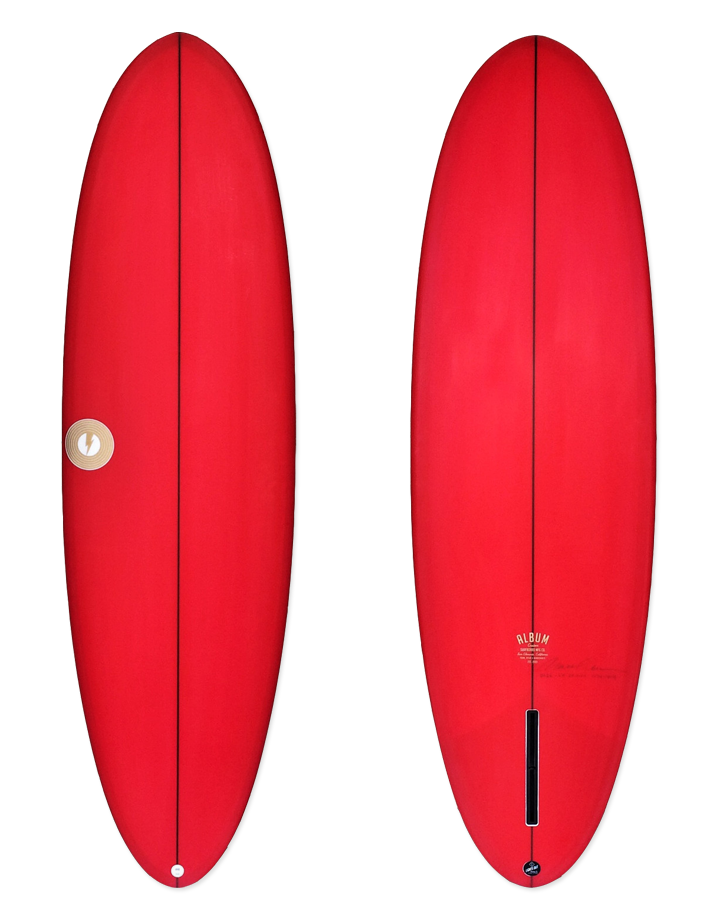
The Disc, another board great for those medium sized days. A board like this has that nice full nose and round tail, giving you the ability to paddle into waves like a longboard, but with a little more maneuverability. Usually set up as a single fin, or commonly found as a 2+1, these boards demand more glide and flow to your surfing. You surf more with the wave instead of on the wave. Again, you can’t count this board out for smaller or larger days. Depending on the size of the board, they can fit into the mid-length category, or shorter stubby style category. Use either in waves anywhere from one foot or up to overhead for the right surfer. Super fun, more traditional feel to surfing where you become more one with the wave.
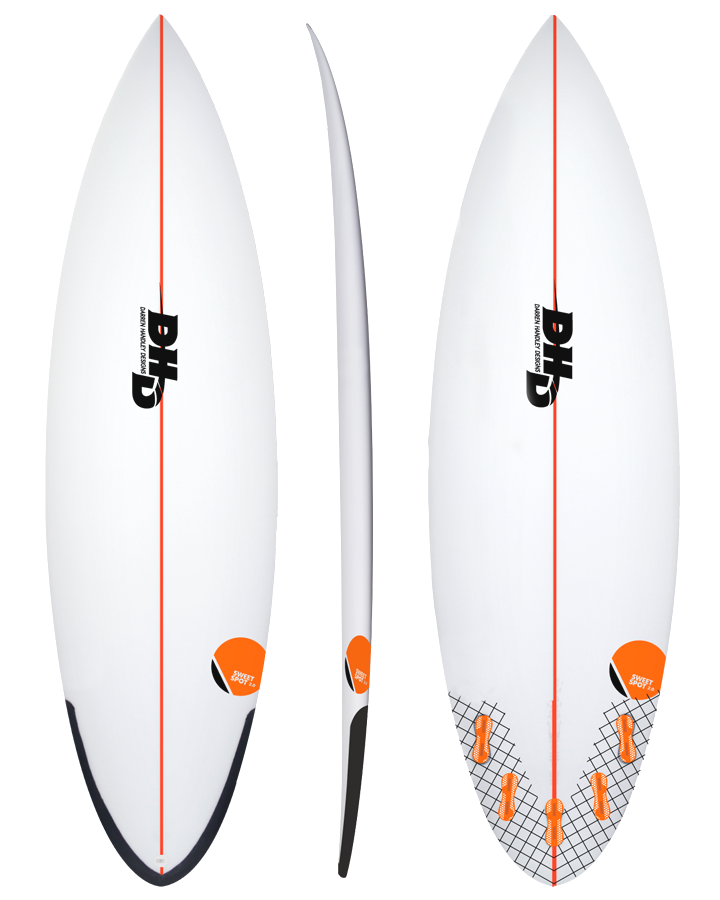
MF Sweet Spot 2.0, although similar to your standard shortboard, make for a great option if you are going to travel or surf new spots a lot. Most of the same attribute as your standard shortboard, but usually in a rounded or rounded-pin tail. This alone widens the versatility of the waves you can surf, while only slightly hindering the high performance snappy turns that a squash gives you. Beyond that small feature, you’ll love this style of shortboard as it’ll work in just about everything. They handles bigger size better while still floating you through smaller or flatter sections. They give you more of a carving feel in your turns instead of snappy, and they love the barrel.

The Step Up, suitably named for the style of board it is, which is a step-up. A must have in the quiver of surfers getting into advanced levels and higher, they are used for those days where your standard shortboard is not enough to handle the size. A little longer, a touch thicker, wide point kept in the center and usually more volume equally displaced all around for paddling. They generally have medium to full rails for stability, and will feature a single to double concave for speed and control. Whether your local turns on or you are going on a trip to Indo, make sure to leave room for your step up.

The Lil Buddy, and similar hybrid boards are designed for those smaller days when you still want to rip around on a shortboard. Usually incorporating elements of a fish and a shortboard, giving you that wider nose and tail area, with more volume through the center, but with higher performance rails and bottom contours. This allows you to get into smaller waves earlier, yet still be able to shred like you would on your normal shortboard. Built for knee high to head high waves, these boards are versatile in the size and conditions you may encounter, but once again, don’t be afraid to take one out when it is a little bigger. They handle size surprising well once you get use to the low rocker and wider nose when coming out of turns.

The SUPER Head Shifter, and similar boards are starting to move into the realm of your standard shortboard. A more refined outline, pulled in versatile tail, high performance bottom contours and usually a medium low rail. These boards are the standard for a reason, they really do work in just about everything with the exception of really small or really big. You can surf these boards anywhere in the world and in waves ranging form knee high to a couple of feet over head, clean or junky conditions. A board that is a must in everyones quiver as they are so reliable and can be taken anywhere with you.
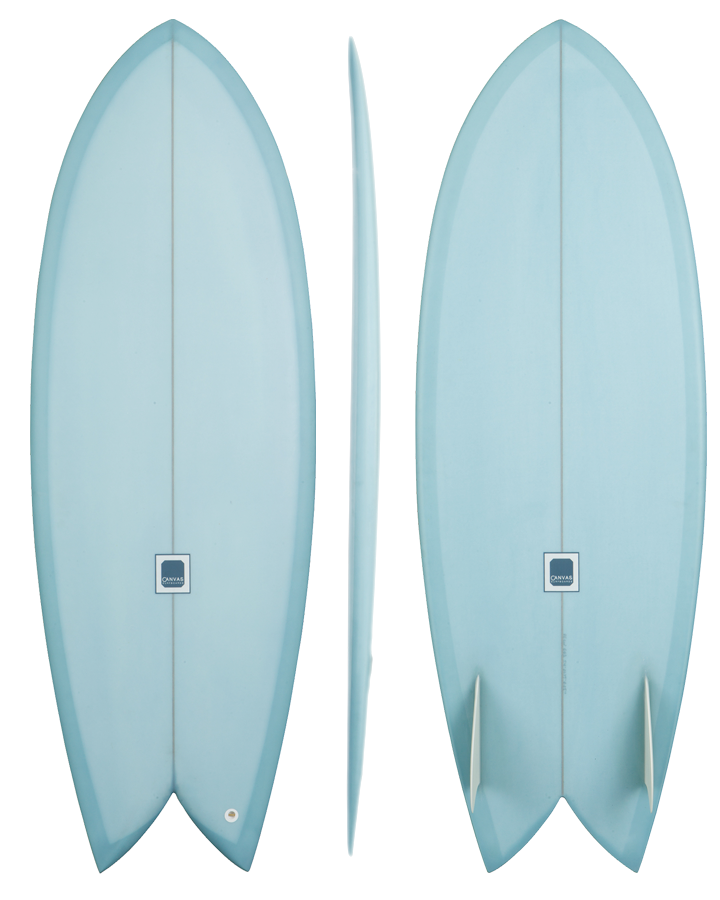
The Bliss Fish, a fun little twin keel fish is perfect for summer days when warm water and wind swell waves are a plenty. This style of board paddles extremely well for their size and are super fast and surprising nimble. Perfect for those small to medium size days and in either mushy or steep faced waves. Don’t count them out though when it is head high and barreling, they are fast and the fish tail (twin pin tails) and short size will hold you in a tight pocket in the waves face nicely. A fish surfboard is a board that everyone should have in the quiver. It’ll open up new lines in your surfing which translate well to when you hop back on your shorty.
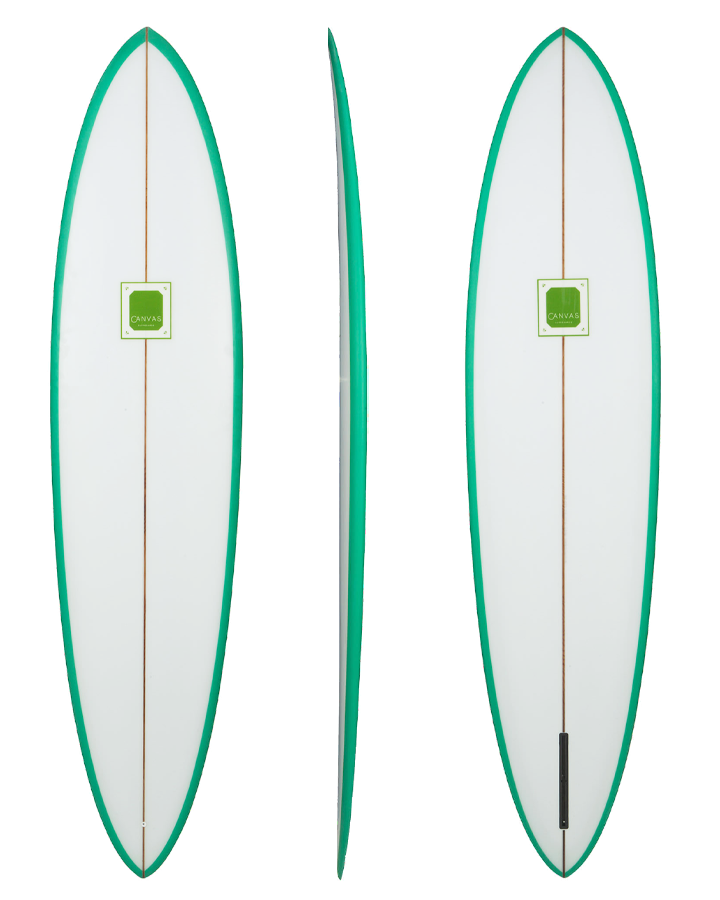
The Tube Shooter, is a step-up style of board for those who love that old school single fin feel. In a board like this you will generally find the wide point forward a bit to help with paddling, and it’ll keep a nice pulled in pin tail to hold you tight in the face when in the barrel. More of a board designed to get you into a wave and get you barrel, they are not the most maneuverable craft. They allow you to hold a nice line in steep waves and are an absolute blast on waves that don’t give you a chance for many turns anyways. Take this board out in hollow waves anywhere from head high.
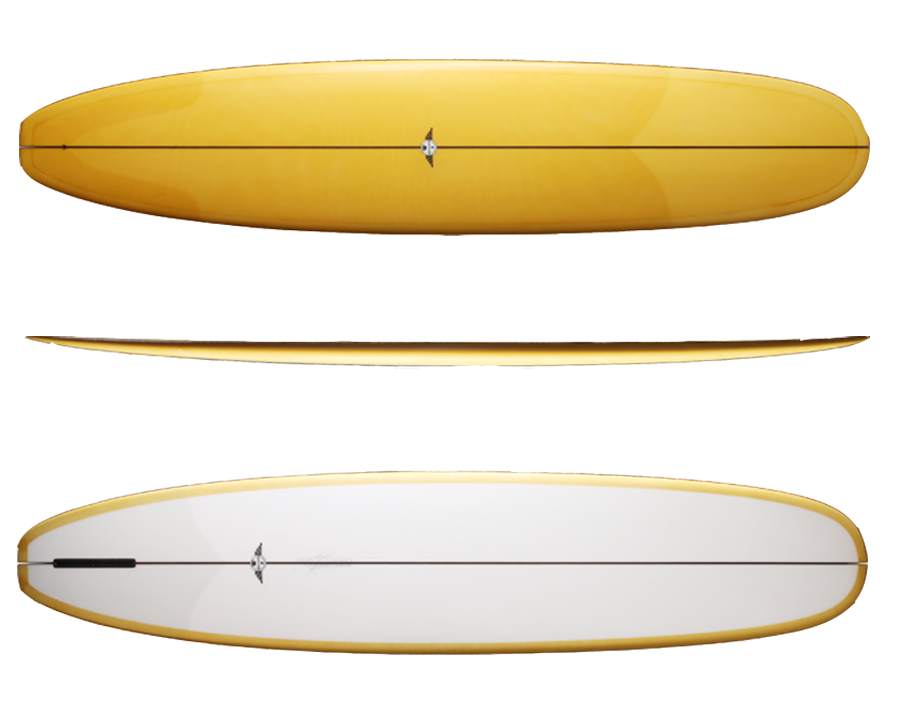
The Hot Doggin Loggin, or other Logs similar to this board, are going to love a softer, rolling wave. “Logs” as they are often referred to, have a low rocker and a long rail line that allow you to get softer, rolling waves earlier. The momentum generated from the length and weight of a board like this carries you through flat sections with ease. However, It doesn’t always have to be small and glassy for you to pull this board out of the racks though…under experienced feet, these boards can handle waves up-to head high or slightly bigger. Even waves with a little more vertical face to them can be a blast on a board like this.
The Run-Down
So there you have it, one of the many dream quivers any of us can own. Please note though, this is not a “set in stone” description of these boards or the waves they are suited for. Your surfing style, creativity, and ability all come into play when surfing any type of board with any type of construction and in any type of condition. We’ve seen longboards in the barrel and standard shortboards in small sloppy waves. It’s surfing after-all, there are no rules. Try it all but remember to stay within your limits.
Finally, get started with exploring a wide selection of beginner surfboards for sale, each tailored to various styles and skill levels. However, your surfing journey doesn't stop there – ensure a holistic experience with essential accessories. Safeguard your ears from harsh conditions with dedicated surf earplugs, and keep yourself securely connected to your board through a dependable surfboard leash.
Protect your investment by storing your boards in top-notch surfboard covers, keeping them pristine and ready for your next adventure. When it comes to hitting the road, our surfboard racks and surfboard straps provide a hassle-free and secure transport solution, allowing you to focus on the thrill of the waves. And if you're seeking to elevate your surf experience, our Boardcave marketplace offers a plethora of surf accessories designed to cater to all your needs.
Make sure you check out the Board Engine and play around with your preferred wave type and board type to find some more surfboard recommendations for your next trip. Alternatively, you can learn more in our article, What Size Surfboard Should I Buy?Popular Surfboards
Shop All SurfboardsCrafting your perfect surfboard
A look at Hand Shaping vs using a CNC machine
The Purity of the Craft
I am sure the debate over the purity of surfboard shaping has been going on continuously probably since the electric hand planer was introduced. There must have been guys sitting in their garage bickering about how the “soul” of a surfboard gets lost when people started using electric tools to do the work where elbow grease, sweat and a few block planes were your shaping tool quiver.

Tools of the trade of legendary Dale Velzy.
The electric hand planer (like the coveted Skill 100, Clark modified Hitachi, the Accurate Planer) was not invented for surfboard shaping. Originally, they were designed as a tool to take the place of block planes, mostly used for truing up and hanging doors, or other flat areas like floors, table tops and decks.
As production demands began to grow for shapers, they had to look for more efficient tools to help get the job done faster and more accurate. In any industry, people have to adapt and explore new tools and ideas that can make their job easier and more efficient.
In today’s world, the CNC shaping machine is that fast and efficient tool, made use by the majority of shapers worldwide. An old phrase that comes to mind – “work smarter, not harder” – holds weight no matter what your job entails.
Here’s the thing with the CNC and CAD programs though, you still have to be a skilled shaper by hand to know how to design a good board on a computer and finish one that was cut on a machine.

Fresh off the machine, but still a long way from finished. Surf Prescriptions Jeff “Doc” Lausch starting to work his magic.
Go Ahead, Make Your Own
One of the biggest fears about the machine, is that anyone can go and “pop-out” boards on a whim. And that this in turn could hurt the industry as we know it, taking jobs away from the craftsmen that have dedicated years into their practice.
Sure, anyone CAN do it, just like anyone CAN get a blank and some tools and hack their own board out. But in reality, you still have to have an understanding of how and why boards and design principles work. You have to know these principles and theories, and you have to be able to hand shape at a high level to get even a decent design out of a CAD file and a machine cut not including understanding different surfboard constructions available.
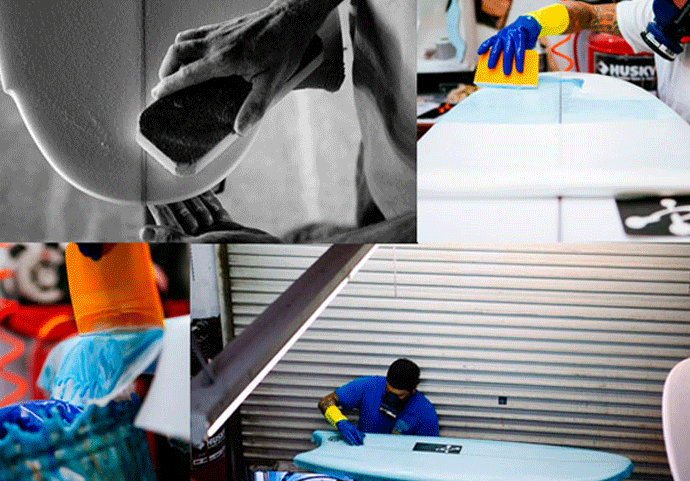
Plenty of “hands on” skill required by the boys at Chemistry Surfboards.
If you have never played around with a CAD file, go download a free program like Shape3D, design a board and see how it really turns out when it comes out of the machine. It is a lot harder than you think. But you’re not done there, you still have to finish shape it to perfection where the majority of skill comes into play and glass it (which is a whole other level in itself).
Machine Assisted, Hand Shaped
Now, most of the detailed shaping comes after a board has been ‘roughed out’. This is the stage that a machine cut will get you too, as opposed to taking an electric planer and doing it by hand.
It saves shapers a little bit of time, and helps to ensure that they can get better results when duplicating certain models.
You will be surprised by the number of shapers you think are “hand only” shapers. Most of them (not all, but most of them) who are coveted as master hand shapers, may still use the machine for their production schedule.
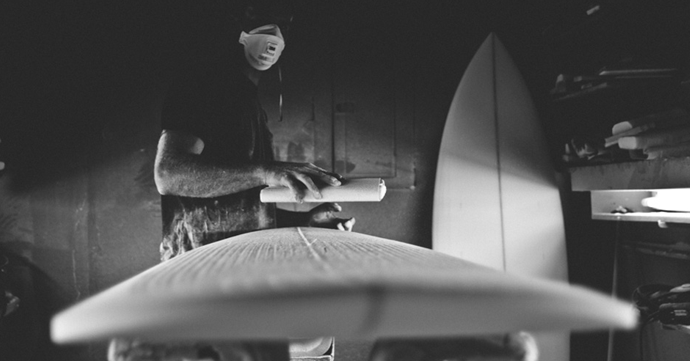
Matt Parker of Album Surfboards knows how to get creative with his hands and CAD designs.
They may spend their time hand shaping and creating a new model until it is dialled in to where they want it. So the creative aspect of shaping the new model is still done by hand for many shapers. After this they can have the board scanned, or the can manually enter all the dimensions needed into a CAD file.
Other shapers (still with a deep knowledge and experience with shaping by hand) learn how to design boards using the CAD program, have it cut and finish it by hand. Either way, the creative process and “soul” of the board is still there, and they can now duplicate models for the team riders and customers.
This comes as a benefit for both the shapers and the customers riding their boards.
Never Lose that Magic Stick
If you happen to break that magic whip you’ve had for years, you may want the exact same board again. With your shaper utilizing the CNC machine, you CAN have that magic board again, and for the rest of your surfing life.
If your shaper only shapes by hand, chances are they are good enough to get it really close but it may not be exactly like that magic board. With the CNC, they can be sure they are duplicating that board for you as well as saving them time.
But please note, most shapers that have been doing it for a while are good enough to duplicate a board only by hand… and on the flip side, a machine cut board can also end up slightly different time to time due to the majority of the work being in the hand finishing the fine detail like rails, bottom contours, etc.
Added Reference Points
Another benefit of CNC machines is the increased use of volumes as surfboard parameter.
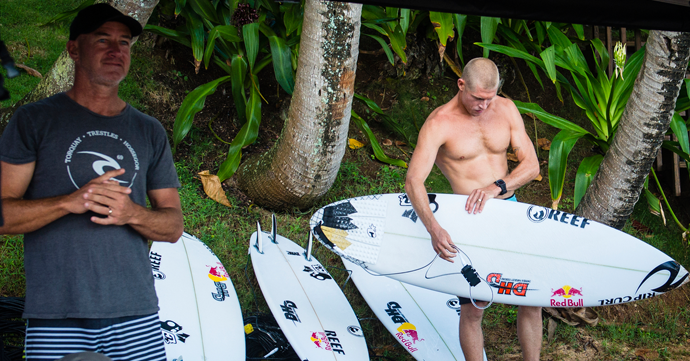
Mick Fanning and Darren Handley of DHD Surfboards constantly refining Mick’s favorite boards.
If you pay attention to what volumes seem to work for you for certain boards, you can refine each new board a little more to suit your needs. You may want two boards of the same model, but tweak the volume and foam distribution to handle different waves if needed.
Like we mentioned in our “Are you surfing the wrong board” article, pro surfers can feel the difference within up to a half liter change in volume. This comes in especially handy for them when they surf around the world in a variety of waves. Knowing a surfer’s ideal volume helps to make those small adjustments in a board to maximize the potential for each individual wave they are going to surf.
Your shaper can live a long fruitful life
The machine has to been seen as just another tool for a shaper, it is not replacing the shaper or shaping skills by any means. It actually can help make a shaper become more well-rounded in their approach as well. They have to learn how to design or tweak a good board in a CAD program, only adding to their skill set.

Custom concave’s and artwork going down at Canvas Surfboards.
To add to that, using a CNC machine actually helps with the longevity of a shapers career. As they get older, lugging the electric planer over blank after blank can take a serious toll on a shaper’s shoulders, elbows and backs.
Always appreciate however, that the majority of shapers who use the machine have put in years and thousands of boards shaped by hand before they adapted to using a machine.
Machines with Morals
Another controversy over the machine has been the possibility and ease of one shaper copying another’s design. It was feared that someone could easily get a hold of your master file and start pumping out the exact same board that you have spent so much time developing.
In reality, there is nothing stopping a hand shaper from doing the same thing, and the CNC machine doesn’t have a mind of its own, so it still comes down to the integrity of the shapers themselves.

Timmy Patterson knows that the machine can’t do channels.
Hand Crafted
Using a CAD program and CNC machine does not mean your boards are in the category of the cheap “pop-out” boards you find at some big box chain retailers. The term “Hand Crafted” still applies with boards still requiring the majority of work to be extremely hands-on. So, there is still plenty of fine craftsmanship that goes into each and every board.
Yes, it does allow a shaper to ramp up their production levels, but the skills required to finish shape, refine and glass the board is still where the majority of the work lies. The machine is not the enemy to the surf industry, it is just another tool shapers can use that is a little too big to fit in their tool box.
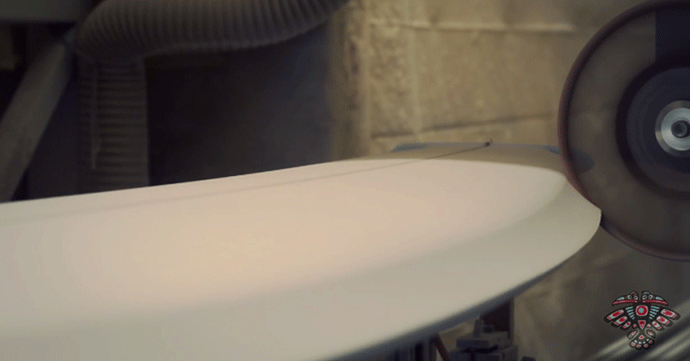
Ryan Engle of Nation Surfboards owns his own machine ensuring he is “hands on” in every board he produces.
What do you think about hand shaping and the use of new technologies? Join the conversation and share your thoughts in the comments below.
Make sure you check out the Board Engine to find a range of boards all manufactured in the USA by professional shapers at the top of their crafts.


















